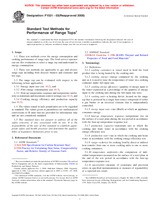We need your consent to use the individual data so that you can see information about your interests, among other things. Click "OK" to give your consent.
ASTM F1521-03(2008)
Standard Test Methods for Performance of Range Tops
STANDARD published on 1.10.2008
The information about the standard:
Designation standards: ASTM F1521-03(2008)
Note: WITHDRAWN
Publication date standards: 1.10.2008
SKU: NS-50618
The number of pages: 9
Approximate weight : 27 g (0.06 lbs)
Country: American technical standard
Category: Technical standards ASTM
Annotation of standard text ASTM F1521-03(2008) :
Keywords:
efficiency, energy, performance, production capacity, production rate, range, range top, throughput, uniform test procedure, Burners, Cooking energy efficiency (CEE), Cooking/food service equipment, Cooking/food service equipment performance, Efficiency, Energy consumption, Energy efficiency, Pilot energy consumption, Production capacity, Range top, Temperature tests--food service equipment, Throughput, Uniform test procedure
Additional information
| Significance and Use | ||||||
|
The energy input rate test is used to confirm that the range under test is operating at the manufacturer's rated input. This test would also indicate any problems with the electric power supply or gas service pressure. The heat transfer characteristics of a cooking unit can be simulated by measuring the temperature uniformity of a steel plate. Idle energy rate and pilot energy consumption can be used by food service operators to estimate energy consumption during non-cooking periods. The cooking energy efficiency is a direct measurement of range efficiency at the full-energy input rate. This data can be used by food service operators in the selection of ranges, as well as for the management of a restaurant's energy demands. Note 1—The PG&E Food Service Technology Center has determined that the cooking energy efficiency does not significantly change for different input rates. If precise efficiency calculations are desired at lower input rates, the full-input rate test procedure is valid for all input rates (that is, less than full-input). Production rate and production capacity can be used to estimate the amount of time required for food preparation and as a measure of range capacity. This helps the food service operator match a range to particular food output requirements. |
||||||
| 1. Scope | ||||||
|
1.1 These test methods cover the energy consumption and cooking performance of range tops. The food service operator can use this evaluation to select a range top and understand its energy consumption. 1.2 These test methods are applicable to gas and electric range tops including both discreet burners and elements and hot tops. 1.3 The range top can be evaluated with respect to the following (where applicable): 1.3.1 Energy input rate (see 10.2), and 1.3.2 Pilot energy consumption (see 10.3). 1.3.3 Heat-up temperature response and temperature uniformity at minimum and maximum control settings (see 10.4), and 1.3.4 Cooking energy efficiency and production capacity (see 10.5). 1.4 The values stated in inch-pound units are to be regarded as standard. The values given in parentheses are mathematical conversions to SI units that are provided for information only and are not considered standard. 1.5 This standard does not purport to address all of the safety concerns, if any, associated with its use. It is the responsibility of the user of this standard to establish appropriate safety and health practices and determine the applicability of regulatory limitations prior to use. |
||||||
| 2. Referenced Documents | ||||||
|
We recommend:
Technical standards updating
Do you want to make sure you use only the valid technical standards?
We can offer you a solution which will provide you a monthly overview concerning the updating of standards which you use.
Would you like to know more? Look at this page.




 Cookies
Cookies
